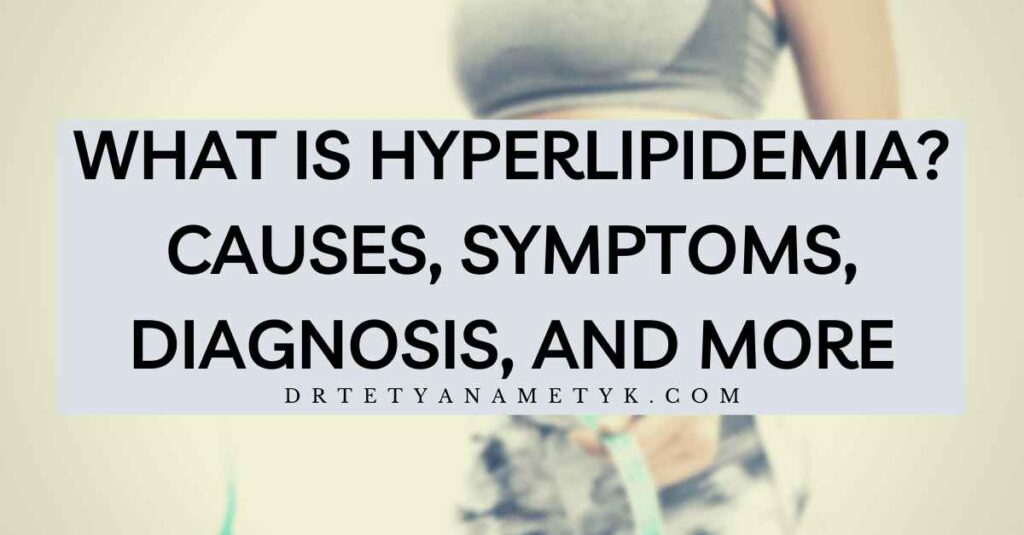In this blog, you will discuss hyperlipidemia and what it is, discuss it in detail, and its symptoms, causes, and diagnosis. Hyperlipidemia refers to a term that means an elevated or increased number of lipids in the blood, as the name implies.
The hyperlipidemia definition is that you have too much or a large number of lipids (fats) in your blood, commonly cholesterol and triglycerides, etc. Hyperlipidemia and hypercholesterolemia mean that there are too many lipids and cholesterol levels or amounts in the blood, non-HDL cholesterol, and LDL cholesterol. It is also known as the bad cholesterol level. You will look at these terms as you’ll in the blog.
This condition of an increased level of fatty deposits in the arteries results in blockage, which causes difficulty and results in clogged arteries which means the blood flow reduces, leading to heart attack stroke. And eventually, death when blood is not appropriately supplied and blocked, which is highly lethal.
What is Hyperlipidemia definition & Hyperlipidemia Meaning?
Hyperlipidemia definition is elevated and high level of the fats in blood or cholesterol, which means deposition of fats in the blood, leading to the blockage of the blood vessels.
Aggregation or accumulation of the excess lipids, fats, and cholesterol leads to a high level of cholesterol in the blood known as hyperlipidemia. Hyperlipidemia, meaning in common terminology (medical term), is known as an abnormal number of fat deposits in our blood.
The word Hyper means high, excessive, and above the normal one. Lipidemia means the presence of lipids or fats in the blood, so hyperlipidemia means a high or excessive level of lipids in the blood.
Non-HDL and LDL Cholestrol
HDL means high-density lipoprotein, which means good cholesterol. It takes the absorbed cholesterol back to the liver, which is then flushed out of the body. Non-HDL is the good cholesterol that is subtracted from the total number of cholesterol present in our body. It mainly measures bad cholesterol, and this number should be lower.
The optimum level of non-HDL cholesterol is less than 130 milligrams per deciliter or 3.37 millimoles per liter. Suppose it is excessive or in higher numbers. It means a higher risk of heart disease developing in people with high non-HDL cholesterol. LDL refers to Low-density lipoprotein. It is one out of five significant lipoprotein groups that aid in the transport or transfer of fatty molecules across the extracellular water environment which is present around the body. Suppose you have a high level of LDL (bad) cholesterol.
In that case, this excess of LDL and the other substances will result in plaque, which is then aggregated or accumulated fatty acids or lipids that block the blood vessels or arteries is known as atherosclerosis. The normal range for LDL cholesterol is less than 100 mg/dL. A level of 100 to 129 mg/dL is good for the people and accepted for those who do not have disease risk factors or who are healthy but risky for those with heart diseases. A quick introduction to both these terms is necessary to understand what hyperlipidemia’s definition and hyperlipidemia’s meaning is.
Causes of Hyperlipidemia
The leading cause of hyperlipidemia is a high-fat diet in which the diet is full of fat and is lipid-rich. It leads to an increased cholesterol level than normal, a person having a sedentary lifestyle. A lifestyle in which the person is sitting and lying down all the time long and is not doing anything.
The laziness or habit of socializing, watching television, playing video games, reading, or using a phone/computer or other digital devices makes a person lazy. Along with these factors, obese and diabetic patients also have a risk factor for hyperlipidemia. A few genetic factors are contributing to hyperlipidemia.
Hypercholesterolemia, which is one of the forms of hyperlipidemia, is the most commonly inherited genetic disorder all around the world among human beings.
Understanding the causes of hyperlipidemia is essential to learn more about the hyperlipidemia definition of and hyperlipidemia meaning.
Following are the most common leading causes of hyperlipidemia:
- When a person smokes frequently, smoking is the cause of hyperlipidemia.
- Drinking too much alcohol is also a contributing factor.
- Eating a fat-rich diet or food (saturated and trans-fat-rich).
- Being lazy and sitting all day long without doing exercise and active works.
- Being too much stressed or depressed.
- Inheritance is also a reason as few genes are inherited, making cholesterol levels high and unhealthy.
- You are overweight and obese.
Symptoms of Hyperlipidemia
The main symptom of hyperlipidemia is stroke symptoms, including difficulty in speaking, drooping on one side of the face, and weakness in the extremities (feet and hands).
The person becomes overweight, and the fat layer increases. As a result, the person becomes obese. Other Symptoms are as follow:
- Chest pain at an early age or young age is known as angina.
- Heart attack at a young age.
- Cramping and muscle weakness while walking or exercising.
- Having sores on the toes which do not heal properly.
- Stroke includes difficulty in speaking and also results in weakness.
- High blood pressure problems as arteries are blocked with plaque.
- Other circulatory ailments.
It would be best if you had cholesterol to be in the normal range or level in your body, which helps generate healthy cells, but when the cholesterol level increases. It causes heart diseases, as mentioned above. But if the fatty deposits aggregate, it results in growing deposits which eventually block the arteries.
Diagnosis for hyperlipidemia
Hyperlipidemia is not directly detectable, so what you have to do is to ask your doctor to have a blood test which is known as lipid panel and lipid profile. As a result, a doctor will use the lipid profile for hyperlipidemia.
This test will determine or identify our cholesterol level. Another method you use for diagnosis purposes is hyperlipidemia screening or measuring serum lipids via a blood test, which tells us about the amount of cholesterol or triglycerides in the blood.
Conclusion
The only way to control any lethal or fatal disease is by making a habit of taking a balanced diet that is healthy for our body and essential for proper nourishment and avoiding a fatty and lipid-rich diet. You ought to exercise regularly to make your body fat-free and reduce the lethal components such as lipids or cholesterol, which helps balance levels of bad cholesterol in our blood.
Furthermore, exercise helps us to stimulate various enzymes, which help move LDL from the blood as much of its concentration or high level is harmful. More exercise will help us expel more fat or cholesterol.
You can consider treatment for your Hyperlipidemia symptoms and more at Dr. Tetyana Metyk’s clinic. For additional information, please visit our Website. You can also Contact Us at any point for medical advice from a qualified physician.


It is unusual for me to discover something on the net thats as entertaining and fascinating as what youve got here. Your page is sweet, your graphics are outstanding, and whats more, you use reference that are relevant to what youre saying. Youre definitely one in a million, great job!